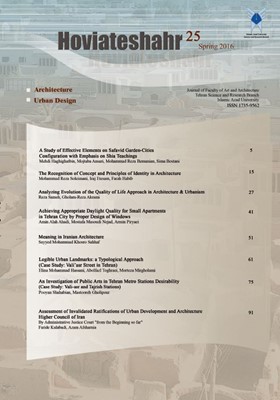Legible Urban Landmarks: a Typological Approach (Case Study: Vali’asr Street in Tehran)
Subject Areas : architectureElina Mohammad Hassani 1 * , Abolfazl Toghraei 2 , Morteza Mirgholami 3
1 - M.A. In Urban Design, Tabriz Islamic Art University, Tabriz, Iran.
2 - Ph.D. Candidate in Urbanism, Tarbiat Modares University, Tehran, Iran.
3 - Assistant Professor, Tabriz Islamic Art University, Tabriz, Iran.
Keywords:
Abstract :
Studies on perceived quality of urban environments, look for ways of establishing harmonious relationship betweenpeople and cities. In the contemporary city, this harmony cannot be seen properly in the relationship betweenpeople and elements that are important in urban legibility. Urban landmarks are one kind of those elements thatwe observe a chaotic attendance for them in Iran’s capital, Tehran. The most common definitions of landmarksindicate that they are some recognizable natural or man-made features used for navigation, features that standsout from their near environment and are often visible from long distances. In urban studies as well as in geography,a landmark is furthermore defined as an external point of reference that helps orienting in a familiar or unfamiliarenvironment. Also, it should be noted that we know urban landmarks as significant elements in both urban landscapeand image. They are conceivably the most fundamental pieces of spatial information as they are used for a widecollection of tasks related to the description, understanding of and reasoning about our physical environment. Inthis paper, we propose a conceptual framework for legibility factors of urban landmarks along urban structuralpathways with emphasis on form, function and meaning. In other words, this paper is to answer the question “whichfactors play the most important role in changing an element, building, etc. to an urban landmark along structuralpathways?” Therefore, in this qualitative research, after considering and summarizing the literature review, aconceptual framework based on the ideas of Lynch, Appleyard and Rapoport was developed. Also, people wererequested to specify urban landmarks they know on a simplified map of the street. Then we identified the mostimportant landmarks (along Vali’asr street in Tehran) based on analyzing people's mental maps. After all, mainfactors/ features of the landmarks were extracted and summarized. The important feature of this study is notonly considering urban landmark as a phenomenon consists of the dialectical relationship between the threecomponents (form, function and meaning), but this is also going to propose a typological analysis of the factorsmentioned above and their variables. Reviewing literature on urban landmarks shows that the main emphasis ofrelevant studies is more on formal and visual aspects rather than functional and semantic. So the focus of thepaper on the meaning of landmarks tried to be comprehensive and novel. The results of this study are to be usedprimarily for urban designers, urban planners and architects to understand what features are important for people toidentify an element as a landmark during the time, and help them to decrease the current chaos in urban landscapeespecially in developing countries urban areas. The results show that functional and formal aspects of landmarksplay a more important role, respectively, in the legibility of urban landmarks. Also type of use, intensity of use andvisibility have greatest impact on identifying those elements. On the other hand, we observed that functional, formaland formal-functional landmarks are, respectively, main types in the case study.... Keywords: Urban Landmarks, Semantic Landmarks, Structural Pathways, Mental Map
12. لینچ، کوین. (1385). سیمای شهر. (منوچهر. مزینی، مترجم). تهران: انتشارات دانشگاه تهران.
_||_

